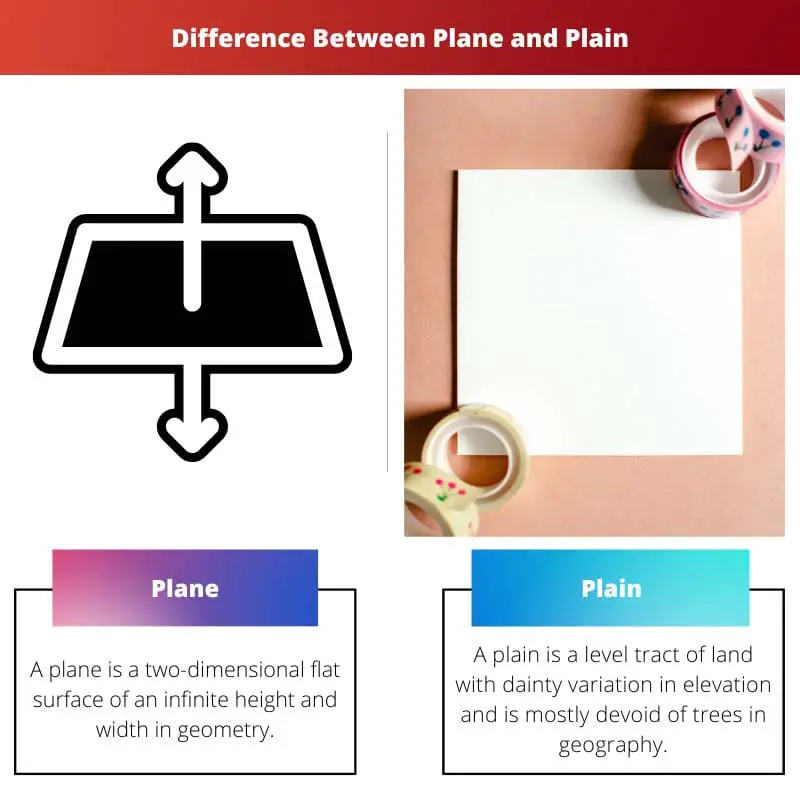Two homonyms that signify flatness are plane and plain. There is a common misconception regarding plain and plane. They denote the same thing in one sense but are utterly different.
The most common meanings of plain and plane are simple, but the most perplexing usage of ‘plain’ and ‘plane’ are two distinct nouns.
Key Takeaways
- A plane is a flat, two-dimensional surface extending infinitely in all directions. At the same time, a plain is a large, relatively flat land area with minimal topographical features, such as hills or mountains.
- In mathematics and geometry, the concept of a plane is used to define various geometric shapes and objects and explore relationships between points, lines, and angles. In contrast, plains are a type of landform found in various regions worldwide, formed by erosion or sediment deposition processes.
- Planes are abstract mathematical constructs, while plains are real-world geographic features that provide habitat for numerous plant and animal species and are utilized for agriculture, settlement, and transportation.
Plane vs Plain
The term ‘plane’ can be used as a noun or a verb. This term can also be used to define an aeroplane. A plane is a type of transport which flies in the air. This term can also be used in mathematics. The term ‘plain’ can be used as a noun, adverb or adjective. This term defines a flat surface. A plain can be created through sedimentation.

As a noun, a plane can mean several things in our daily life, such as an aeroplane, a level surface of anything or a tool for levelling wood.
As a verb, it is an act of smoothing or levelling something. It is a state of being or awareness within a spiritual or religious context.
Plain is an adjective that describes something straightforward, uncomplicated, or obvious. Plain refers to a flat, treeless area of the terrain.
They are a prime landform on land and are necessary for large-scale agriculture. The Atlantic Coastal Plain of the United States East Coast is one of the most well-known examples.
Comparison Table
| Parameters of Comparison | Plane | Plain |
|---|---|---|
| Description | It is a flat surface above the ground. | It is a flat surface on the ground. |
| Origin | First recorded in 1375–1425 from middle English word plaine, pleine. | First known use in the 14th century from the Middle English word ‘planum’. |
| Formation | It is supposed to exist in a vacuum. | A continuous process of deposition and sedimentation creates it. |
| Significance | Mathematicians use it primarily to solve problems in geometry. | In geography, it has a lot of significance for agriculture and farming. |
| Examples | The only thing left to do was pack and take a plane home. He proved the law of equilibrium on an inclined plane. | Her room was plain and basic. The interior, plain in itself, contains eye-catching sculptures. |
What is a Plane?
A plane is a two-dimensional flat surface of an infinite height and width in geometry. It is a fundamental element in geometry. The word plane first appears in a mathematical context in the early 1600s.
It derives from the Latin word plānum, which means ‘flat surface’, and the Latin adjective plānus, which means flat.
The English word plane can have different meanings and usage in different kinds of sentences, such as:
A vehicle with wings and designed for air travel;
For example, He is scared of travelling by plane.
A flat or level surface that spans in all directions in mathematics:
For example, Meena saw a building with angled planes.
A specific standard or level:
For example, His artistic work is of a different plane.
a tool for flattening and smoothing wooden surfaces and edges
For example, The carpenter forgot to bring his plane and equipment to work.
Some of the synonyms of a plane are aeroplane, craft, flat, even, horizontal, smooth, flush, grade, uniform, face, regular, degree, condition, extension, facet, footing, grade, horizontal, and obverse.
Some of the antonyms of a plane are coarse, uneven, rough, unsmoothed, lumpy, and bumpy.
Phrases Containing plane are the Cartesian plane, complex plane, equatorial plane, inclined plane, polarization plane, plane-polarized, plane table.

What is Plain?
A plain is a level tract of land with dainty variation in elevation and is mostly devoid of trees in geography. A ‘plain’ can occur as lowlands in valleys or at the foot of mountains, coastal plains, plateaus, or uplands.
When a geological region has more than one plain, a pass connects them called a gap. Coastal plains rise gradually from sea level until they reach higher terrain, such as mountains or plateaus.
Plains are one of the most common landforms on land, occupying more than one-third of the planet’s total area. There are plains on every continent.
Lava can form mountains and plains, ice, rain, or wind can deposit sediment, or mountains and hills can erode the soil. Grassland, steppe, savannah, or tundra are some biomes found on plains.
Deserts and rainforests may be called plains in some cases.
Plains are significant for agriculture in many locations because sediments deposited on plains may be deep and fertile. Also, the flatness promotes technology-driven crop production or they sustain grasslands that give suitable grazing for livestock.
Common synonyms of ‘plain’ are bare, unadorned, down(s), grassland, unvarnished, pampa, tundra, and simple.
Some antonyms of ‘plain’ are fancy, adorned, embellished, ornamented, and decorated.

Main Differences Between Plane and Plain
- A plane is a noun, adjective, and verb, whereas plain is an adjective, adverb and noun.
- A plane is a flat surface that is high above the ground. A flat surface on the earth is plain.
- From the Middle English term plaine, pleine, the term ‘plane’ appears first between 1375 and 1425. ‘Planum’ was the Middle English term for plain in the 14th century.
- A plane should be able to exist in a vacuum. Deposition and sedimentation are the processes that create a plain.
- It is most commonly used in geometry to solve difficulties. Plains have a lot of relevance in geography for agriculture and farming.

- https://books.google.com/books?hl=en&lr=&id=oOWAnvkrD70C&oi=fnd&pg=PA417&dq=Difference+Between+Plane+and+Plain&ots=UriSHaFLOm&sig=2pfBSLgiL9oHp8ywp0uv4OcxcXY
- https://link.springer.com/article/10.1007/s00586-010-1610-8
